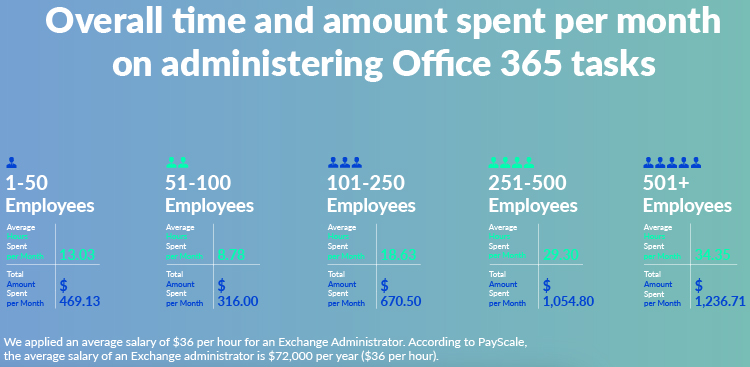Understanding the True Management Costs of Office 365
In the latest edition of Redmond Channel Partner magazine (RCPmag.com), a short article by Editor in Chief Scott Bekker caught my eye in which he shares some important data points from a recent report from Champion Solutions Group, who surveyed a small sample of Office 365 administrators to try and quantify the total cost of ownership (TCO) of managing Office 365. This topic goes back several years for me, back when I was a member of the Microsoft Managed Solutions (MMS) team in 2006-2007, which was the precursor to BPOS (Business Productivity Online Services) and then Office 365. I remember sitting in my office talking with peers Charles Ofori, Kimberley Ward, and Mike Watson about the early licensing models, and different factors that would impact the TCO of the fledgling platform. Specifically, we were trying to outline the benefits for a new customer that was coming online, who had been asking for this information.
A handful of years later, while serving as Chief Evangelist at migration and administration ISV Axceler, the topic came up again from time to time, once again in context to customer questions as they tried to internally understand the true costs of managing SharePoint – and using their understanding of these internal costs to justify a strategy to move from on-prem to the cloud. While the sample set is small, it does validate a few things that I’ve seen over the course of my career with Office 365 – primarily that it provides the best value for small to medium-sized businesses (SMBs), but due to the need for customizations, integrations, and hybrid solutions, that cost can increase for the enterprise. Again, it does not appear that this study took into account these more complex scenarios, but the data shared, in my mind, is directionally correct with these assumptions.
From the report’s executive summary:
Generally speaking, time spent managing Office 365 increases as the number of users in an organization increases. But there are exceptions. Would it surprise you to learn that the smallest organizations spend double the average monthly hours on billing and invoice reconciliation compared to organizations that are five times their size? This is only one of the unique insights MessageOps learned from our recent survey of Office 365 administrators.
Office 365 is a price-effective program that gives organizations access to a suite of productivity and collaboration tools while enabling them to more easily maintain compliance and security standards. It also transforms large capital expenditures to an easily scalable Subscription as a Service (SaaS) line item.
MessageOps conducted a survey of 101 Office 365 Administrators to gauge how much time is spent on a range of Office 365 functions and give organizations an idea of how they compare to their peers when managing this environment. Respondent organizations ranged from 1-50 to 501+ Office 365 users.
Discover the key findings and recommendations based on the survey results.
You can download a copy of their findings here.
Bekker spoke with Champion CEO Chris Pyle, of which MessageOps is a business unit, about his takeaways from the study, and Pyle quickly identified the obvious value of a centralized Office 365 platform:
“How much time do you spend backing up your mailboxes? How much time do you spend retrieving a mailbox that’s been deleted? How much time do you spend on failover testing a quarter? How much time do you spend on server performance? How much time does accounting spend, worrying about the depreciation cycle of the hardware?”
One of the major growing pains for Office 365 has been administration. As the platform brings together more workloads, and streamlines the administration, reporting, auditing, and permissions structure, we’re seeing more and more capability available out of the box. However, many customers continue to look to ISV solutions for more robust capabilities – all of which still lag behind the mature administrative solutions available for on-prem.
I look at this space as one of the primary partner opportunities for Office 365, especially when it comes to the added wrinkle of hybrid environments. I’ll be writing a lot more on this topic going forward, but for the time being, Microsoft has some great content and community discussions on the topic, so be sure to visit and bookmark the following sites:
- Office 365 for business – Admin help (Support.Office)
- Office 365 admin videos (Support.Office)
- About the Office 365 admin center (Support.Office)
- Office 365 community forum (TechCommunity.Microsoft)
- Office 365 Admin (UserVoice)
- Office 365 Reporting (UserVoice)
- Common management tasks for Office 365 (Support.Office)
I hope you find this information useful.





